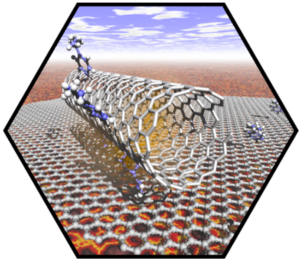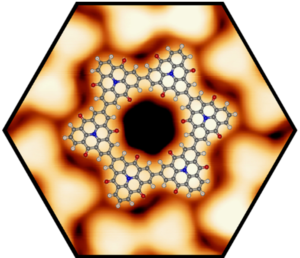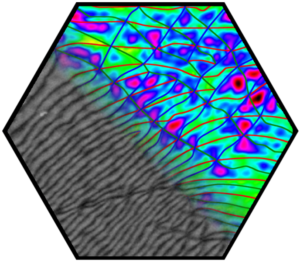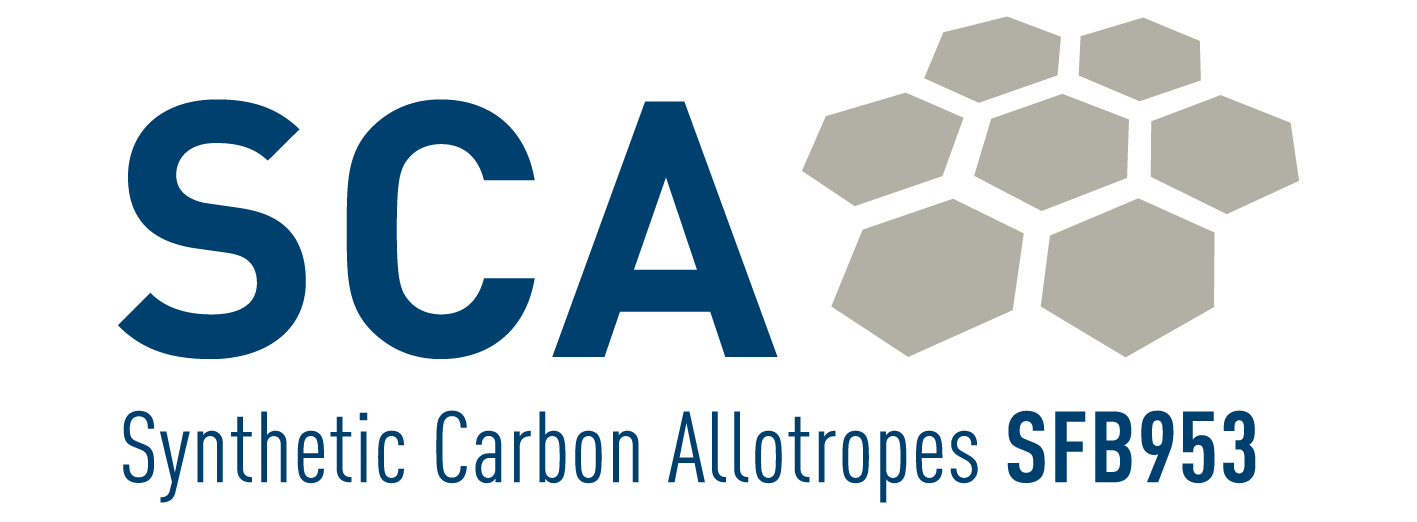Phase II – Focal Topics
Phase II – Focal Topics
For the second funding period, we defined three research themes as focal topics. This decision is based on the fact that these fields (a) constitute very hot subjects and represent important challenges for the area of carbon allotrope research, (b) require complementary expertise by several of SFB 953 PIs across different disciplines, and (c) proved already to be very successful throughout the first funding period – especially in terms of prolific collaborations documented by e.g., a multitude of high quality joint publications. The focal topics are as follows:
 The different – and at the same time tunable – properties of 0D-fullerenes, 1D-nanotubes, and 3D-graphene and the increasing knowledge about precise processing techniques offer the unprecedented challenge to construct for the first time nanostructured inter-carbon hybrids. The possibilities of both structural variations and properties engineering are in principle limitless. Next to the development and perfection of supramolecular and physico-chemical construction principles, which are fundamental and very exciting on their own right, new perspectives for practical applications also arise. All-carbon electronics, for example, would offer benefits such as high stability, low price processing, recyclability, and tenability. In the first funding period, we have already demonstrated that proto-type architectures containing e.g., fullerenes derivatives and graphene building blocks can be constructed. It is now our intention to initiate in the second funding period a joint effort to push the construction and characterization of inter-SCA architectures a considerable step forward.
The different – and at the same time tunable – properties of 0D-fullerenes, 1D-nanotubes, and 3D-graphene and the increasing knowledge about precise processing techniques offer the unprecedented challenge to construct for the first time nanostructured inter-carbon hybrids. The possibilities of both structural variations and properties engineering are in principle limitless. Next to the development and perfection of supramolecular and physico-chemical construction principles, which are fundamental and very exciting on their own right, new perspectives for practical applications also arise. All-carbon electronics, for example, would offer benefits such as high stability, low price processing, recyclability, and tenability. In the first funding period, we have already demonstrated that proto-type architectures containing e.g., fullerenes derivatives and graphene building blocks can be constructed. It is now our intention to initiate in the second funding period a joint effort to push the construction and characterization of inter-SCA architectures a considerable step forward.
 On-surface covalent chemistry represents a potent alternative for the bottom-up construction of various carbon-based architectures which are otherwise inaccessible through conventional synthetic methods. This process can also be monitored by scanning probe microscopy techniques. Moreover, the approach appears to be particularly attractive in the context of carbon-based molecular electronics, since the respective nanostructures can be fabricated directly on a surface. This field currently experiences a dynamic expansion, as we and others recently demonstrated the rational construction of nanographenes, nanoribbons, fullerenes, and nanotubes. However, the portfolio of employed precursors, substrates, and chemical transformations still remains rather narrow, which consequently leads to limited diversity of the resulting nanostructures. In the first funding period, we have already achieved highly-ordered, two-dimensional, covalent networks with carbonyl-functionalized pores and provided the initial evidence for the on-surface synthesis of graphyrins. Based on these important results on heteroatom-doped carbon architectures we will further push our interdisciplinary efforts throughout the second funding period to broaden this approach towards new types of functionalized precursor molecules and substrates. Moreover, the surface assisted synthesis of hemispherical buckybowls (nanotube seeds) and helicity controlled growth of carbon nanotubes will be addressed. This will allow us to implement hitherto unexplored chemical reactions to the on-surface synthesis of unprecedented carbon-based architectures with tailored properties and geometry.
On-surface covalent chemistry represents a potent alternative for the bottom-up construction of various carbon-based architectures which are otherwise inaccessible through conventional synthetic methods. This process can also be monitored by scanning probe microscopy techniques. Moreover, the approach appears to be particularly attractive in the context of carbon-based molecular electronics, since the respective nanostructures can be fabricated directly on a surface. This field currently experiences a dynamic expansion, as we and others recently demonstrated the rational construction of nanographenes, nanoribbons, fullerenes, and nanotubes. However, the portfolio of employed precursors, substrates, and chemical transformations still remains rather narrow, which consequently leads to limited diversity of the resulting nanostructures. In the first funding period, we have already achieved highly-ordered, two-dimensional, covalent networks with carbonyl-functionalized pores and provided the initial evidence for the on-surface synthesis of graphyrins. Based on these important results on heteroatom-doped carbon architectures we will further push our interdisciplinary efforts throughout the second funding period to broaden this approach towards new types of functionalized precursor molecules and substrates. Moreover, the surface assisted synthesis of hemispherical buckybowls (nanotube seeds) and helicity controlled growth of carbon nanotubes will be addressed. This will allow us to implement hitherto unexplored chemical reactions to the on-surface synthesis of unprecedented carbon-based architectures with tailored properties and geometry.
 In two-dimensional materials like bilayer graphene, stacking faults appear as lines that thread through the sample. Any electron traversing the material has to cross such lines, which provide quantum mechanical barriers. Due to the specific Bernal stacking in bilayer graphene and its two-fold degeneracy, the case is a non-trivial quantum-mechanical problem. We have strong indicators that many phenomena, which have been observed in bilayer graphene (and that have been tentatively explained by many-body effects), can be traced back to the unavoidable presence of stacking faults. Graphene bilayer, however, provides a particularly clear example on how important stacking faults in the low-dimensional materials are, because one can fully read out its open-lying defect structure. We will use this opportunity to obtain as much as structural information as possible (by TEM, STM, AFM, etc.), that are combined with electronic data (transport, magneto-transport, Leem potentiometry mapping), optical imaging (plasmon mapping), and specially adapted quantum-mechanical calculations in order to develop a full picture of the underlying physics. We will explore techniques to manipulate stacking faults, either mechanically, thermally, or current-driven. The unprecedented approach will yield results that are valuable for any stacked two-dimensional material.
In two-dimensional materials like bilayer graphene, stacking faults appear as lines that thread through the sample. Any electron traversing the material has to cross such lines, which provide quantum mechanical barriers. Due to the specific Bernal stacking in bilayer graphene and its two-fold degeneracy, the case is a non-trivial quantum-mechanical problem. We have strong indicators that many phenomena, which have been observed in bilayer graphene (and that have been tentatively explained by many-body effects), can be traced back to the unavoidable presence of stacking faults. Graphene bilayer, however, provides a particularly clear example on how important stacking faults in the low-dimensional materials are, because one can fully read out its open-lying defect structure. We will use this opportunity to obtain as much as structural information as possible (by TEM, STM, AFM, etc.), that are combined with electronic data (transport, magneto-transport, Leem potentiometry mapping), optical imaging (plasmon mapping), and specially adapted quantum-mechanical calculations in order to develop a full picture of the underlying physics. We will explore techniques to manipulate stacking faults, either mechanically, thermally, or current-driven. The unprecedented approach will yield results that are valuable for any stacked two-dimensional material.

